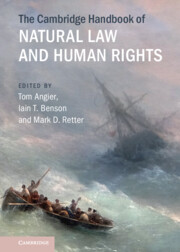Book contents
- The Cambridge Handbook of Natural Law and Human Rights
- The Cambridge Handbook of Natural Law and Human Rights
- Copyright page
- Contents
- Contributors
- Acknowledgements
- Introduction
- Part I Natural Law and the Origins of Human Rights
- 2 Natural Law and Human Rights
- 3 The Paradox of Shrinking Individuality
- 4 Synderesis, Conscientia, and Human Rights
- 5 The Case against the Marriage of Natural Law and Natural Rights
- 6 The Mythical Connection between Natural Law and the Universal Declaration of Human Rights
- 7 Natural Law and the Universal Declaration of Human Rights
- Part II Natural Law Foundations of Human Rights Obligations
- Part III Natural Law and Human Rights within Religious Traditions
- Part IV The Human Person, Political Community, and Rule of Law
- Part V Rival Interpretations and Interpretive Principles
- Part VI Challenges and Future Prospects
- Index
5 - The Case against the Marriage of Natural Law and Natural Rights
from Part I - Natural Law and the Origins of Human Rights
Published online by Cambridge University Press: 03 November 2022
- The Cambridge Handbook of Natural Law and Human Rights
- The Cambridge Handbook of Natural Law and Human Rights
- Copyright page
- Contents
- Contributors
- Acknowledgements
- Introduction
- Part I Natural Law and the Origins of Human Rights
- 2 Natural Law and Human Rights
- 3 The Paradox of Shrinking Individuality
- 4 Synderesis, Conscientia, and Human Rights
- 5 The Case against the Marriage of Natural Law and Natural Rights
- 6 The Mythical Connection between Natural Law and the Universal Declaration of Human Rights
- 7 Natural Law and the Universal Declaration of Human Rights
- Part II Natural Law Foundations of Human Rights Obligations
- Part III Natural Law and Human Rights within Religious Traditions
- Part IV The Human Person, Political Community, and Rule of Law
- Part V Rival Interpretations and Interpretive Principles
- Part VI Challenges and Future Prospects
- Index
Summary
This chapter outlines three positions on the desirability of a marriage of the natural law and natural rights traditions: (i) that natural law and natural rights may be united without any recourse to revelation; (ii) that natural law and natural rights may be united but only by recourse to revelation; and (iii) that any form of union between natural law and natural rights should be avoided as contrary to the common good and the well-being of the City of God. It is argued that the third position is the preferred on the grounds that the natural rights tradition is difficult to translate into a non-individualistic, communitarian framework. Social bonds and civic ties revolve primarily around mediating institutions such as the family and cultural, educational, and sports associations, not around the machinery of the state and abstract concepts. Unlike Bills of Rights that enumerate rights attached to individuals, the alternative Common Law tradition presupposes that human persons live in communities, that human life is relational, and that conflicts arise for adjudication when a clash of claims occur that need to be resolved with reference to some higher common good.
Keywords
- Type
- Chapter
- Information
- The Cambridge Handbook of Natural Law and Human Rights , pp. 74 - 87Publisher: Cambridge University PressPrint publication year: 2022



